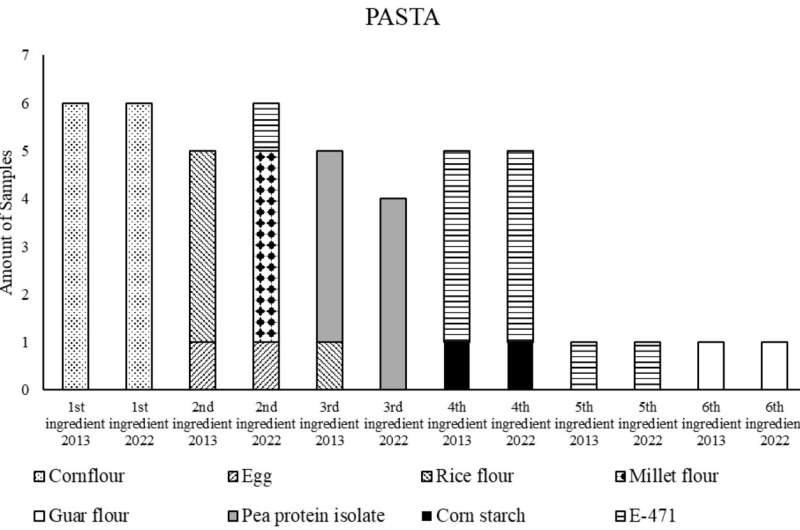This article has been reviewed according to Science X's editorial process and policies. Editors have highlighted the following attributes while ensuring the content's credibility:
fact-checked
trusted source
proofread
Monitoring gluten-free products to analyze whether they are nutritionally deficient

Over the years, cases of celiac disease have increased exponentially. According to experts, there may be two reasons for this. One is that the number of celiac individuals has been rising as a result of environmental factors, and the other is that diagnoses have improved and increased. Besides celiac disease, gluten may trigger other disorders.
The increase in cases has reached public perception, which has created a problem because people regard a gluten-free diet as healthier than a gluten-containing one. This misconception may be counterproductive.
"Certain attributes that are not in themselves related to diet are ascribed to diet. The data show that gluten-free products are not healthier," according to Jonatan Miranda-Gómez, pharmacist at the UPV/EHU and researcher in the Gluten 3S research group. This group is accredited for granting the ISO standard seal that guarantees that gluten-free products are actually gluten-free.
Miranda's team has in fact been carrying out a nutritional analysis of gluten-free products for many years. "In 2014, we published a fairly ground-breaking scientific paper," said Miranda. "In it, we compared 200 gluten-free foods with their gluten-containing equivalents. Nutritionally, they are not on a par with each other."
Many of the gluten-free products contained more unsaturated lipids (or harmful fats) than gluten-containing ones, they were lower in fiber, and their salt and protein content needed to be monitored. But the situation is changing all the time and the results of another study have just been published in the journal Foods.
Evolving over a nine-year period
The proportion of celiac individuals has not changed and remains at approximately 1%. However, the population has increased and gluten sensitivities have also emerged, which means that when this group is also taken into consideration, the problem affects 10% of the population.
"The industry has been aware of that," said Miranda. "So it has developed more products, which has allowed the industry itself to do more research and take other components into consideration. To a certain extent, this social and research team momentum has led to an evolution in the industry. And there has been a remarkable improvement."
Pasta is a case in point. Gluten-free pasta is not made from wheat, because it contains gluten, but from maize. Maize flour has in fact always been the main ingredient. This has not changed in the last nine years. However, whereas in the past the second most important ingredient was rice flour, today the most common ingredient is millet.
"This has had a positive effect on nutrition," said Miranda. "To produce pasta, you have to extrude it, and millet allows extrusion to be carried out using fewer lipids." In addition, food legislation initiatives have contributed, as changes in recent years have led to changes in pasta ingredients.
In the case of non-solid products, producers resort to other strategies. One example is beer. In this case, instead of the gluten being replaced, it is broken down by the addition of enzymes during the clarification process (when suspended particles are separated from the liquid). "But this process has another limitation," added Miranda. "Harmful molecules may go unnoticed during routine analysis. Members of the celiac Association sometimes tell us that gluten-free beer disagrees with them."
So a new line of research has been opened to analyze the problems of these beers.
As far as Miranda is concerned, the issue is clearly a broad one. "In recent years, articles have shown that other molecules may also be harmful and that, even if a strict gluten-free diet is followed, these gluten-free products can still cause discomfort. They also want to add another focus to the research and look at the environmental aspect."
"We want to find out the environmental impact of gluten-free food. They tend to have a greater impact than the rest, because some ingredients need to be imported from abroad, for example. That impact would need to be reduced. For example, the sourcing of millet needs to be explored," said Miranda.
More information: Claudia Mármol-Soler et al, Gluten-Free Products: Do We Need to Update Our Knowledge?, Foods (2022). DOI: 10.3390/foods11233839



















